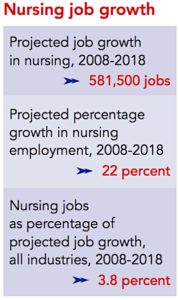You may or may not have heard about the nurse shortage the US is currently battling.
Major metropolitan nurses aren’t feeling the effects yet; however, experts predict that in 10 years the US will be facing a nurse shortage of over 250,000 qualified nurses! As baby boomers cross the ‘senior’ threshold of 65, hospitals will be seeing more traffic. Worse, the education system isn’t doing its job to produce the nurse brothers and sisters we need!
It’s not just an aging population and a generation of nurses leaving the ranks (much respect), but the education system is flawed. In 2013, baccalaureate programs across the nation turned away nearly 80,000 qualified nursing students. Age is also affecting nursing faculty numbers; now more than ever, students are being pushed toward other areas of study in a time of need for the industry, merely contributing to the nurse shortage as a whole.
 The American Nurses Association reports that good old supply and demand will drive growth in the nursing industry to the tune of 22% by 2018. In a workforce of over 2.5 million, that is around half a million nurse jobs to open or 3.8% of overall job growth in the US during the same period.
The American Nurses Association reports that good old supply and demand will drive growth in the nursing industry to the tune of 22% by 2018. In a workforce of over 2.5 million, that is around half a million nurse jobs to open or 3.8% of overall job growth in the US during the same period.
Hospitals and care facilities nationwide are going to need updated strategies to deal with the environment a nurse shortage will bring. From the state of technology in hospitals we’ve discussed in previous posts, they need all the help they can get…
 Nurses are the single most important assets for hospitals to manage. We know that, but it often feels like management does not. Nurses are the lifeblood of hospitals. Well-staffed and happy nurses make a hospital tick and push the bottom line numbers as well. So pay attention! In 2013, there were almost five nurses to every physician in hospitals, and as a group, nurse labor expense made up around 25% of a hospital’s overall costs. That’s more than physicians, equipment, or, insurance. Considering that hospitals managed a 2.6% margin last year, that means a one percent change in nurse costs can translate to significant gains or losses on the big stage. Here we have the main reason to look for nurse-centric technology that will drive efficiency.
Nurses are the single most important assets for hospitals to manage. We know that, but it often feels like management does not. Nurses are the lifeblood of hospitals. Well-staffed and happy nurses make a hospital tick and push the bottom line numbers as well. So pay attention! In 2013, there were almost five nurses to every physician in hospitals, and as a group, nurse labor expense made up around 25% of a hospital’s overall costs. That’s more than physicians, equipment, or, insurance. Considering that hospitals managed a 2.6% margin last year, that means a one percent change in nurse costs can translate to significant gains or losses on the big stage. Here we have the main reason to look for nurse-centric technology that will drive efficiency.
Hospitals are aware of the costs of not acting, but managers and others are slooooow to bring about change. Hospital leadership struggles to align in consensus on the solutions needed. It may be time for nurses to give a try to bringing in technology themselves to better their lives and hospital environments. With the numbers to create a movement, a solution in the hands of nurses may be the answer to some of the issues that are surfacing on the precipice of the nurse shortage!
